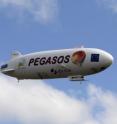Clean air: Fewer sources for self-cleaning
Up to now, HONO, also known as nitrous acid, was considered one of the most important sources of hydroxyl radicals (OH), which are regarded as the detergent of the atmosphere, allowing the air to clean itself. A research group from Jülich has put an end to this conception. The new hypothesis is based on air measurements recorded by a Zeppelin NT within the framework of the EU PEGASOS project. The prevailing assumption about the role of HONO in atmospheric chemistry as a pure source of radicals now has to be completely overhauled. The results have appeared in the peer-reviewed journal Science. OH radicals are central to the air's self-cleaning capacity. In the global atmosphere, they are most frequently formed when ozone is split by sunlight. For the lowest atmospheric layer, referred to as the planetary boundary layer and extending to an altitude of up to two kilometres, there used to be an additional explanation: here, the splitting of HONO by sunlight was considered at least as important an OH source. However, the analysis of measured data from the PEGASOS campaign indicates otherwise. Although the exposure of HONO to light does release OH radicals, they are quickly consumed to create new HONO. Nitrous acid is therefore not a net source of OH. This also contradicts the prevailing conviction that HONO is responsible for around 80% of OH radicals produced in polluted air, for example in large cities.
"Our findings overturn existing knowledge on HONO and solve an enigma that had dominated research for some 20 years, namely why researchers consistently measured more HONO than expected in the lowest atmospheric layer," says troposphere researcher Prof. Andreas Wahner from Jülich's Institute of Energy and Climate Research, which coordinated the study and the measurements. For years, research groups from all over the world had been seeking an unknown source of HONO -- albeit in the wrong place. Most experts assumed that surface effects on the ground were responsible. "This is also a reason why HONO measurements were only performed on the ground or near the ground up to now. Our measurement flights with the Zeppelin NT over the Po Valley in northern Italy in summer 2012 was the first time that data were recorded at higher altitudes above the Earth's surface," says Wahner.
Back then, the Jülich scientists and their colleagues spent five weeks measuring trace gases like nitric oxide (NO), OH radicals, and HONO, as well as aerosols in the air and meteorological parameters at altitudes of up to 1,000 metres. The measurement campaign was part of the EU-funded project PEGASOS (Pan-European Gas-AeroSOl-Climate Interaction Study), which examined the influence of atmospheric chemistry on the air quality and on the climate. The airship allowed the Jülich researchers to investigate atmospheric layers that have no contact with the surface of Earth for long periods of time. It was here that they discovered large quantities of HONO that remained almost constant even after sunrise. They had expected that sunlight would destroy HONO while forming OH. The constantly high concentration can only be explained by a previously unknown process that continuously creates new HONO.
Based on these findings, the researchers derived a hypothesis explaining the formation of new HONO from various trace gases. They developed a chemical reaction model, which they then used to calculate the expected concentrations of the various substances and compared the results with the empirical data measured over northern Italy. "We were surprised how well our measured data agreed with our theory," says Dr. Xin Li, first author of the study, which also involved researchers from the University of Wisconsin, USA.
"Our findings show that existing assumptions on the role of HONO must be completely overhauled. HONO production in the atmosphere is a continuous cycle in which the ingredients are first produced and then re-consumed," explains Andreas Wahner. The consequence: "The scientific community must reassess its understanding of how HONO influences the chemistry in the troposphere," concludes Dr. Franz Rohrer, who was responsible for data analysis and interpretation. The newly discovered HONO source must be investigated in more detail. Further field experiments and laboratory studies are necessary to understand the relevant processes properly.
Source: Forschungszentrum Juelich
Other sources
- Fewer sources for self-cleaning air: Study overturns existing knowledge on nitrous acid, HONOfrom Science DailyThu, 17 Apr 2014, 20:40:29 UTC
- Clean air: Fewer sources for self-cleaningfrom PhysorgThu, 17 Apr 2014, 18:12:36 UTC
